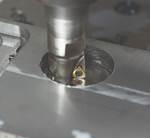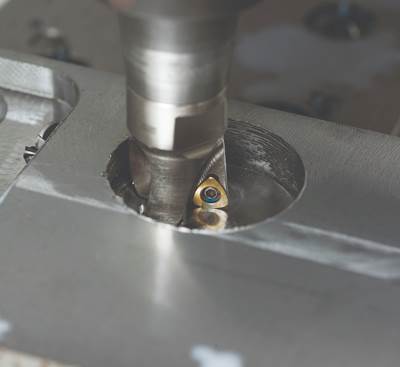Finding the Right High-Feed Indexable Milling Tool
The value of versatility and reliability in your high-feed machining solution.
Moldmakers are constantly seeking to be a step ahead of the competition in service and quality, and for many, a goal continues to be improving productivity. Many have realized that by applying high-speed and/or high-feed concepts with machine tools, and often more effectively with tooling, they could achieve significant improvements.
High-feed milling has been discussed and attempted since the beginning of the 20th century, but due to technical limitations it wasn’t effectively applied in the real milling world. Continued strides in implementing both high-speed and high-feed milling have been made possible by the evolution of CNC machining centers coupled with the latest cutting tool designs and programming.
At the beginning of this century, machine tool builders began to offer solutions for which they were sacrificing rigidity for speed. They understood that by designing lighter, faster machines they could increase productivity and tool life when machining different components. This new mindset combined with the latest electronics improvements helped make it possible for CNCs to be more capable of managing higher data volume, achieving complex shapes, and all while being more precise at higher feedrates. Today’s CNCs are also fully connected with CAD/CAM systems, which have also evolved—taking into account the user’s exact demands and the latest generation of cutting tools—by offering specific strategies to support optimum toolpaths. As a result of all of this, the latest generation of cutting tools and milling machines are all well connected.
Two Key Qualities
For moldmakers, each mold or component represents a new application—sometimes with a new challenge—and because there is no room for error, every milling tool used by a moldmaker needs to possess two main qualities: versatility and reliability.
Versatility is especially valuable since moldmakers regularly face a broad range of cutting assignments on large or small components over an equally broad range of materials, including tool steels, low- and high-alloy steels, and high-temperature alloys. Indexable cutting tools that can accomplish numerous high-feed operations including profiling, pocketing, ramping, plunging, and face milling over this wide material spectrum particularly prove their worth.
Reliability is vital because in comparison to conventional milling, high-feed milling can be operated at up to 10 times faster feed per tooth. This is mainly due to much shallower axial depths-of-cut to fully exploit chip-thinning principles. The net gain can be a metal removal rate (MRR) two to three times higher than conventional milling, increasing a customer’s capacity and shortening throughput time.
A Quality Solution
Conventional milling processes are based on high depths-of-cut that could potentially decrease tool life and MRR due to larger radial components of force taking place -- more vibrations and inconsistent performance. This often results in lowering feedrates to compensate. To address the versatility and reliability factors in high-feed machining, there is now a double-sided insert with six indexable cutting edges specifically designed for high-feed applications which moldmakers may want to consider.
Moldmakers will note the higher feeds and lower depth-of-cut will totally change chip formation, decreasing radial forces, and therefore reducing vibrations. Due to such small radial forces, these inserts have performed well, even with long overhangs, machining up to X10L/D at higher feedrates. In tests comparing conventional inserts, the conventional inserts had a three to one advantage in depth of cut, but the high-feed inserts ran more than eight times faster, resulting in a 110 percent increase in metal removal rate at 20 percent lower cutting forces.
Indeed, with smaller lead angles, such as 12 degrees, feedrates for high-feed cutting tools must be significantly higher to provide minimum chip thickness and result in correct cutting processes. For example, in cutting tests pocketing and slotting triple-alloy steel (AISI 9840), an 80 mm screw-on extension was used. Conventional milling inserts were fed at 2.3 mm/min at a spindle speed of 1650 rpm with the metal removal rate result being 59 cubic centimeters/min over the tool’s life. The high-feed milling insert was fed at 4.5 mm/min at the same spindle speed and generated a 95 percent higher metal removal rate at 115 cubic centimeters/min.
Roughing strategies can become much more effective with the correct high-feed milling application, since high feeds and shallow axial depth-of-cut make it possible to produce components to near net shape, thereby eliminating the need for a semi-finishing operation. This not only reduces leadtime, but also opens up valuable machine capacity to accommodate other jobs.
Summary
High-feed milling strategies can increase metal removal rates across a variety of moldmaking cutting operations (slotting, pocketing, ramping, and face milling, to name a few). Because of their lower cutting forces and smaller depths of cut, despite much higher feed rates, they can be relied on to reduce vibrations and lower cutting forces, extending both spindle and tool life. Versatility and reliability added together can result in increased moldmaker efficiency.
Related Content
Solving Mold Alignment Problems with the Right Alignment Lock
Correct alignment lock selection can reduce maintenance costs and molding downtime, as well as increase part quality over the mold’s entire life.
Read MoreHands-on Workshop Teaches Mold Maintenance Process
Intensive workshop teaches the process of mold maintenance to help put an end to the firefighting culture of many toolrooms.
Read MoreThe Ins and Outs of Hot Runner Temperature Control
A training checklist that explains the why and how of proper hot runner temperature control and system management.
Read MoreTreatment and Disposal of Used Metalworking Fluids
With greater emphasis on fluid longevity and fluid recycling, it is important to remember that water-based metalworking fluids are “consumable” and have a finite life.
Read MoreRead Next
6 Ways to Optimize High-Feed Milling
High-feed milling can significantly outweigh potential reliability challenges. Consider these six strategies in order to make high-feed milling successful for your business.
Read MoreHow to Use Continuing Education to Remain Competitive in Moldmaking
Continued training helps moldmakers make tooling decisions and properly use the latest cutting tool to efficiently machine high-quality molds.
Read MoreAre You a Moldmaker Considering 3D Printing? Consider the 3D Printing Workshop at NPE2024
Presentations will cover 3D printing for mold tooling, material innovation, product development, bridge production and full-scale, high-volume additive manufacturing.
Read More













.png;maxWidth=300;quality=90)







